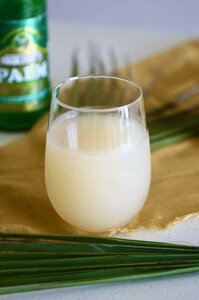It is an alcoholic, sweet and tasty drink obtained from the sap of various types of palms found in the tropics, different parts of Asia, Africa, the Caribbean and South America.
Pulp is usually obtained from the highest parts of the plant, where young boys from villages, called tappers, climb. The sap is harvested and left to ferment with the yeast present in the air. The extraction method involves placing a small fire in the trunk of a felled palm to release its juice, which is then collected in cups. The white juice starts fermenting as soon as it flows out. Two hours are enough to develop the alcoholic component in palm wine with the same alcohol content as in regular beer. As fermentation takes place very quickly, this explains why traditional palm wine producers sell their wine immediately after extraction.
Traditions
In many cultures, palm wine has gained significant cultural significance to such an extent that it is mentioned in various art forms.
In Central and West Africa, palm wine is mainly used for wedding celebrations. It plays an important role in the social structure and order of the rural village.
In some villages in Cameroon, a certain amount of all the wine harvested still has to be offered to the village chief. In addition, sharing wine with the "boss" of the village is perceived as a sign of loyalty and respect. Social life in Cameroon revolves around a palm wine stall, a place that is as popular as European tea houses.
In Africa, palm wine is often associated with wedding ceremonies, customs or religious ceremonies.
In some tribes, the dowry required of the future groom includes an alcoholic beverage. It symbolizes the eternal connection between spouses. By offering a glass of palm wine to her father, the bride seals the union of both spouses forever.
During festivals, palm wine is often used when they are opened. It is spilled on the ground and is meant to remind dead ancestors who should not be forgotten.
In Nigeria, it is also called a kind of popular music: "palm wine music".
Palm wine trees
There are many types of palm trees, about twenty-seven, from which palm wine is obtained. Nine of these species come from Africa.
The oil palm, also known as Elaeis guineense, is the most widely used on the African continent.
The most used some types for the production of palm wine:
Dates (Phoenix dactylifera L.),
a plant widely grown mainly for its fruit called dates.
Wild date palm (Phoenix sylvestris),
also known as silver date palm, Indian date palm, sugar date palm. It is a species of numerous flowering plants found in southern Pakistan, India, Sri Lanka, Nepal, Bhutan, Burma and Bangladesh. The fruits of this type of palm, which grow in plains and shrub areas up to 4,000 feet (1,300 m) above sea level, are used not only to make palm wine but also to make jelly. Fresh juice is boiling. It is used to make jaggers, palm sugar ...
Flowers for Caryota Urens,
from which sapphire kitulu is obtained is a palm tree that grows in Sri Lanka and southern India. This juice has been consumed for centuries and is recognized for its nutritional properties. Ideal for sweetening desserts (white cheese, ice cream, vegetable milk or fruit salads), also suitable for baking. It contains 3 sugars: fructose, glucose and sucrose, which is a balance that prevents the body from storing these carbohydrates. Kitul pulp actually has a very low glycemic index and provides few calories (less than 300 calories per 100 g). It is therefore a very good alternative to white sugar.
Palm nypa,
which consists of only one species, nypa fruticans. This palm tree can create real mangroves in South Asia. It is a very old species. Fossil pollen remains of this mangrove palm, estimated to be 70 million years old.
Rafio palm trees,
which is a genus of about twenty species of palms native to the tropics of Africa and especially in Madagascar, while one species (R. taedigera) also occurs in Central and South America.
Advantages of palm wine
One of the reasons why palm wine is so popular is the importance of its benefits. It is a drink not only exceptional for the taste that sets it apart, but also for the health benefits it brings to the body. A panacea for health that combines pleasure and well-being.
The content of riboflavin, also called vitamin B2, is very high: it is an antioxidant, very useful for our health. Palm wine is also rich in vitamin C and vitamin B1. In terms of mineral salts, this drink is rich in iron and potassium, two micronutrients for good health. Thanks to its nutritional profile, it is believed that it can improve eye health to such an extent that older people have incredibly sharp eyesight in the villages where it is usually consumed. The presence of mineral salts is useful for the proper functioning of some cells in our body, while maintaining a healthy heart and is able to control high blood pressure.
It is considered a very strong aphrodisiac in many areas where palm wine is commonly consumed, but its benefits could go even further: a recent study has shown that palm wine can protect people with erectile dysfunction and impotence due to type 2 diabetes. Palm wine is an alcoholic beverage, so it should be consumed carefully and in moderation.
Palm wine is known by various names in different countries:
- Algeria: legmi
- Benin: atan a sodabi, destilované palmové víno
- Burkina Faso: bangui
- Cameroon: mimbo, matango, mbuh a sodébi
- Central African Republic: kangoya
- Kongo-Kinshasa: kikongo
- Ivory Coast: bandji (baoulé), koutoukou
- Ghana: doka, nsafufuo, yabra a déha
- Malaysia: kallu, nira, toddy, bahar a goribon
- Nigeria: emu, oguro, ogogoro, palmový tombo likér a nnmaya ngwo
- South Africa: ubusulu
- Tunisia: qêshem a legmi mayeet



Commets 0
Add a comment